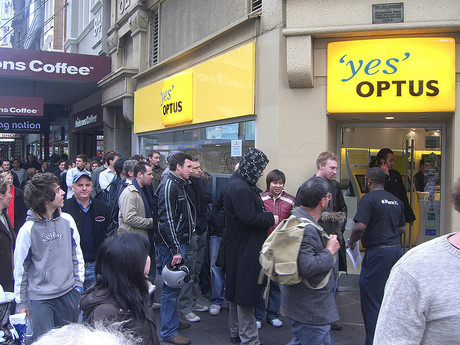Optus trials 4.5G as Telstra prepares to test 5G

Optus and equipment vendor Huawei have completed a live trial of 4.5G wireless networking technology, achieving peak data rates of 1.23 Gbps over the air in live network conditions.
Huawei is developing 4.5G technology as a stopgap between 4G, or LTE, and the 5G technology expected to be commercialised in 2020.
During the field trial in Newcastle, the company also achieved download speeds of 1.41 Gbps in a cabled scenario.
The tests involved combining technologies including carrier aggregation — which involves combining spectrum from multiple frequency bands — and 4x4 multiple input multiple output (MIMO), the next evolution of the technology involving using multiple antennas to transmit and receive wireless data.
The companies aggregated five 20 MHz spectrum carriers for the trial. Current commercial LTE-Advanced networks typically only aggregate two or three carriers.
Dennis Wong, Optus Networks acting managing director, said the trial forms part of Optus’s preparations for the arrival of 5G technology, which is expected to deliver data rates in the 10 Gbps range.
Telstra is also looking to lay the groundwork for 5G. The company has announced that it plans to work with Ericsson to trial 5G technologies at the 2018 Commonwealth Games on the Gold Coast.
The company announced ahead of this week’s Mobile World Congress trade show that it plans to start testing 5G technologies in Australia this year ahead of the trial at the Games.
Recent trials of 5G with Ericsson in Sweden achieved speeds of more than 11 Gbps in real-world indoor settings.
In addition, Telstra plans to upgrade parts of its network in Sydney, Melbourne and Brisbane to support the latest evolution of the LTE standard LTE Cat 16, which promises peak data rates of up to 1 Gbps.
Telstra is working with Netgear to develop a Cat 16 mobile hotspot, which is expected to be the first commercially available device to support the standard.
The report adds that Telstra plans to introduce voice over Wi-Fi calling technology in the first half of the year and video over LTE calling in the second half.
Separately, Telstra announced that it has upgraded its network to support Category 1 LTE devices, intended for components of the Internet of Things (IoT).
On the Telstra Exchange blog, the company’s group managing director for networks, Mike Wright, said key components of LTE Category 1 include a far lower cost for the LTE chip, in the $5 or less range, much longer battery life and much deeper coverage.
This makes the category ideal for IoT devices including sensors, wearables and applications that need to send low to moderate amounts of data.
“NB-IoT will be the next big breakthrough in that it will also provide deeper coverage into buildings and extend existing remote and rural penetration beyond our current geographical coverage. NB-IoT has a lower data rate than Cat 1 and Cat M and will enable even lower cost devices,” he said.
“We will be partnering with Ericsson and our device partners later this year to bring the NB-IoT and Cat-M technology to Australia for network trials and demonstrations to the industry. These NB-IoT trials will pave the way for the expected rapid growth in the machine-to-machine sector, leveraging our existing 4G service infrastructure forming part of our mobile network.”
IoT demands alternatives as 3G sunset looms
The impending 3G shutdown is a daunting prospect for organisations across ANZ that rely on...
Broadband measurement shows online gaming stacks up
The ACCC's latest Measuring Broadband Australia report has found that consumer connections to...
BlackBerry stopping one cyber attack per minute
A new report from BlackBerry's Threat Research and Intelligence team highlights the...







